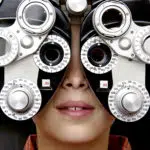World Keratoconus Day is observed on November 10 every year. It is a National Keratoconus Foundation-funded initiative that is part of the Gavin Herbert Eye Institute at UC Irvine. Keratoconus, also known as ‘K.C.,’ is a non-inflammatory eye disorder that damages the cornea. A person with KC experiences a change in their cornea, which loses its round dome shape and eventually thins and weakens. This alteration causes the cornea to expand into a cone-like shape, resulting in substantial vision loss. This day is committed to raising awareness and sharing resources about keratoconus.
History of World Keratoconus Day
Burchard Mauchart, a German oculist, first cited a case of keratoconus disease in his doctoral dissertation in 1748, when he described the condition. He named the disease ‘staphyloma diaphanum’ in his thesis.
In 1854, the British physician, John Nottingham clearly described the disease by differentiating it from other diseases of the cornea. Nottingham discovered numerous symptoms that were comparable to the “conical cornea” instances he had observed. These symptoms included corneal weakening and an inability to deliver corrective lenses suitable for the patient’s vision.
In 1859, British surgeon William Bowman became the first person to be able to use an ophthalmoscope in order to diagnose keratoconus. Bowman also instructed the right angle needed on the mirror to be able to see the cone-like bulge of the cornea in the patient. Bowman also attempted to restore the patient’s vision by pulling on the iris and stretching the pupil into a vertical slit resembling a cat’s eye using a fine hook. He claimed to have had some success with the approach, claiming to have been able to restore the vision of an 18-year-old lady who couldn’t count her fingers at a distance of eight inches before.
Johann Horner, a Swiss ophthalmologist wrote a thesis titled “On the treatment of keratoconus” in 1869, which solidified the name of the disorder in the medical community. At the time, the disease’s therapy consisted of utilizing chemicals to physically reshape the cornea’s conical shape. After numerous experiments, Ramón Castroviejo performed the first effective treatment of the condition in 1936 through corneal transplantation.
World Keratoconus Day timeline
The German oculist Burchard Mauchart first mentions a case of the keratoconus disease in his doctoral dissertation where he calls it ‘staphyloma diaphanum.’
British physician John Nottingham finds symptoms that are similar to the cases of conical cornea, which include weakness of the cornea and being unable to match corrective lenses to the patient's vision.
British surgeon William Bowman becomes the first to use an ophthalmoscope in order to diagnose keratoconus.
Johann Horner, a Swiss ophthalmologist publishes a thesis titled “On the treatment of keratoconus,” which solidifies the name of the disorder in the medical community.
The treatment is done by the surgeon Ramón Castroviejo through the method of corneal transplantation.
World Keratoconus Day FAQs
What percentage of the population has keratoconus?
Keratoconus occurs in approximately one in every 2,000 individuals. The chances of getting the disease are slim but not unlikely.
Are you legally blind if you have keratoconus?
Keratoconus can cause vision loss up to a point where your visual acuity in both eyes is 20/200 or worse. If it is this low then a person with keratoconus in the United States is considered legally blind and may qualify for disability benefits.
What foods are good for your cornea?
Your diet can help improve your eyesight and ensure good eye health. Fresh fruits like blueberries, kiwi, grapes, avocados, orange juice, fish, and different kinds of nuts are all good for your eyes.
How To Observe World Keratoconus Day
Share on the internet
Read up on the disease and share information about it on the internet to raise awareness. It can be very helpful to some.
Go for an eye checkup
How long has it been since you had your eyes examined? Take advantage of this opportunity to visit your eye doctor and get a test performed.
Start a healthy diet
There are numerous nutrients that are beneficial to your eyes. To maintain strong eyesight, try to eat a balanced and healthy meal every day.
5 Facts About Keratoconus That You Need To Know
It starts during the teenage years
Biological changes such as puberty or pregnancy have been reported to cause early onset of keratoconus
It usually affects both eyes
Keratoconus is a predominantly bilateral disease that affects both eyes.
Fluctuating vision
A patient with K.C. will need a new pair of glasses or lenses every few months due to their changing vision.
Custom-made contact lenses for K.C.
Due to the irregular surface of the cornea, customized hard contact lenses called RGP or Rigid Gas Permeable lens, are used.
It can cause contact lens intolerance
Contact lenses tend to rub against the cornea while the patient blinks due to the cornea’s irregular surface, making it uncomfortable after sometime
Why World Keratoconus Day is Important
To raise awareness
This day is an opportunity to share information and resources about keratoconus. We must first educate ourselves about the disease and then others around us.
To prioritize eye health
Eye health is critical since it provides us with the ability to see. As a result, we must get regular eye exams and consume a nutritious diet to preserve good eye health.
To improve quality of life
This day can help people with keratoconus learn more about the treatment options available to them and how to access them. It has the potential to raise revenue for their medical expenditures as well as encourage more study.
World Keratoconus Day dates
| Year | Date | Day |
|---|---|---|
| 2025 | November 10 | Monday |
| 2026 | November 10 | Tuesday |
| 2027 | November 10 | Wednesday |
| 2028 | November 10 | Friday |
| 2029 | November 10 | Saturday |






